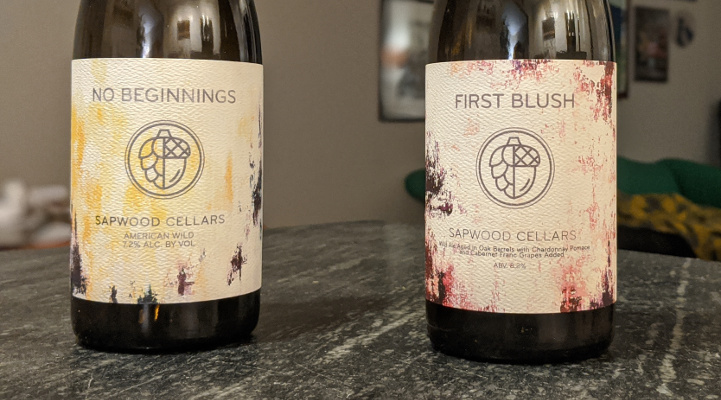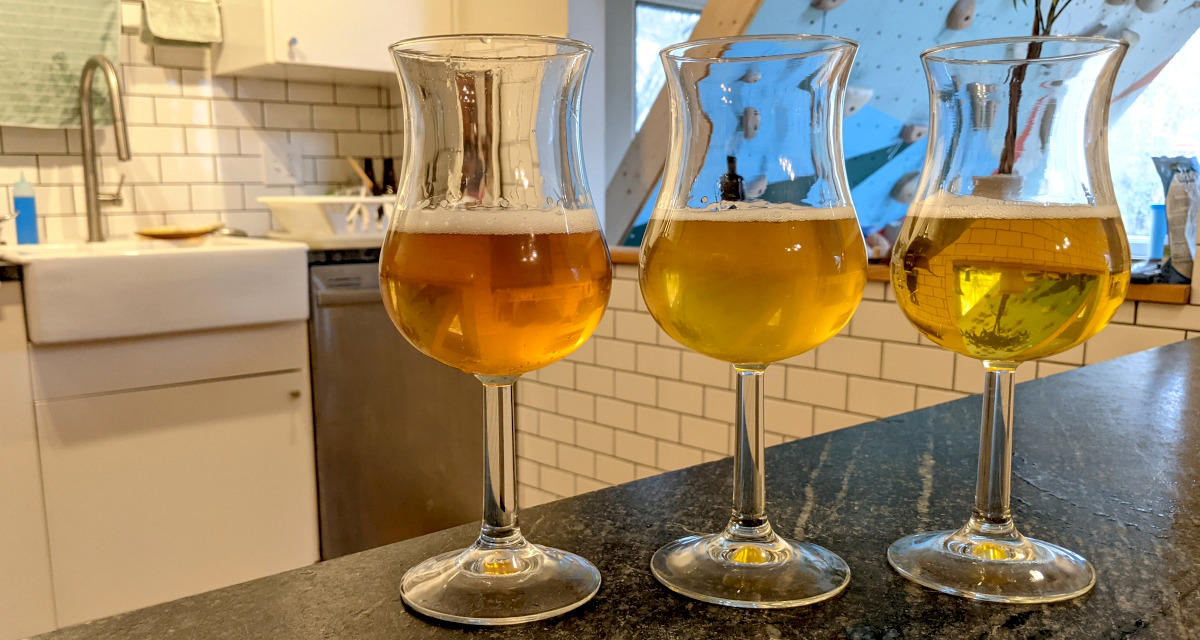Vitus Vinifera is the scientific name for the species that contains most varieties of wine grapes.
This “Saison Vinifera” will blend funky tart saison, oak, and wine.

A large portion of my homebrewing over the last six months has been focused on trying to emulate the great mixed fermentation beers coming out of my favorite local brewery, Sapwood Cellars. Two of those beers were delicious tart saisons that they released in fall 2019:
No Beginnings was a pale saison with Brettanomyces, aged in Sauvignon Blanc wine barrels.
I’d be willing to bet that First Blush started life as a similar base beer to No Beginnings, but it was fermented with chardonnay pomace, and finished on whole Cabernet Franc grapes. It is rosé in appearance and the flavor has a unique light, tart fruitiness.
My plan is to brew a batch of funky pale saison, split it half in secondary, and see how close to each of these I can get
Recipe
I know Sapwood uses Bootleg Biology’s Mad Fermentationist Saison Blend, but because of COVID-19 related shutdowns I can’t get any Mad Fermentationist Saison Blend right now, and I’m not sure when I’ll be able to in the future.
However, I was able to find some Omega C2C American Farmhouse (OLY-217) recently. It has different strains of Sacc and Brett, but I’m hoping its character will be in the ballpark of what I’m aiming for.
Batch size: 6 gallons
Target OG: 1.047
Target FG: 1.003
Calculated IBU: 27.5
Calculated SRM: 3.2
Grain bill:
8.5lb US 2-Row (85%)
1.5lb Flaked Wheat (15%)
Mash (Batch Sparge): 148 °F @ 1.5 qts/lb
Hops:
0.35 oz Columbus @ 60 minutes
2.0 oz Hallertau Blanc, 15 minute hop stand
Yeast:
Most of a decanted 1.5L starter (intermittent shaking)
Omega C2C American Farmhouse
Notes
2020-03-26 - Made a 1.5L starter the same night I made the Spring Kolsch starter. Shook intermittently for a couple days then put it in the fridge.
2020-04-04 - Brew day. Threw some rice hulls in the mash to avoid a stuck sparge with the flaked wheat. Mash 149 °F, Close enough.
Pre-boil gravity of 1.039 was a little lower than expected so I added 8oz of pilsen light DME.
OG came in at 1.048. Pitched the yeast, reserving maybe 25% of it to use in a future saison I have planned. Who knows when I’ll be able to buy a mixed sasion blend next.
Primary in a 6.5 gallon bucket, heated to 74 °F in a water bath with an aquarium heater.
Active fermentation about 6 hours after pitching. That was unusually fast. Happy yeast.
2020-04-25 - Blending with wine and some berliner weisse for tartness. SG 1.006 before blending. The sample tastes nice. A little peppery, little bit of brett character already I think.
I did some small samples of blending the saison and berliner to get a rough idea of what ratios I wanted. I didn’t have a good way to do the tiny dosing required to test out the wine ratios so I just kind of guessed based on what I’ve seen others do successfully online before. I went pretty heavy on the wine.
A piece of advice I saw from Mike Tonsmeire was “I think a cup in 5 gallons is about right for “wine barrel aged” level of flavor, and a bottle is about right for a present wine flavor (depending on the beer and wine of course).”
The red wine half got 0.4 gallons of berliner, 16oz of Cabernet Sauvignon (equivalent of a whole bottle in 5 gallons), and then I filled the rest of the 3 gallon carboy to the neck with saison.
The white wine half I was aiming to get a little more tart, and a little less wine forward. It got 0.6 gallons of berliner, 10oz of Sauvignon Blanc, and I filled the rest of the 3 gallon carboy to the neck with saison.
I had enough left over to get a few 750ml bottles of the plain base saison. That should be interesting to compare with the blended versions. Being 1.006 and having brett, I’m hoping it’ll drop a couple more points and carbonate nicely as is. I’ll taste one in a couple months and if it’s not carbonated I can add some additional sugar.
Each 3 gallon carboy also got 0.3 oz of med toast american oak cubes that I boiled for a few minutes. I’ll take a gravity reading in about a month, and bottle a month from there if it’s stable.
2020-06-04 - Taking a quick gravity sample. It looks like there’s still some slow activity in the airlock. The red wine half is down to 1.004. Things are going pretty fast considering a month ago I blended it with about 15% berliner that was at 1.015. It’s starting to develop some funk but still pleasant so far. I’ll check the gravity again in July.
2020-07-11 - Red half still 1.004. Thinking of bottling soon.
2020-07-20 - Noticeable air lock activity since my last measurement. Come on, I thought you were done. Will keep an eye on it and keep waiting…
2020-09-06 - 1.003. Getting impatient. Let’s live a little dangerously. Going to blend most of the red half with my overly-sour raspberry sour and bottle. I’ll leave the white alone for now. I’m planning on needing it for the very sour apricot pale later this year.
In the end I got, 10 bottles of plain red wine saison, 4 bottles of straight raspberry sour, the rest was blended ~55/45 sour to saison. This blend was mildly sour. At the time the plain raspberry sour was tasting way too sour on its own. It’ll be interesting to see how it tastes once carbonated.
Conservatively primed the plain saison with 17g of sucrose for 2 vols
Individually primed the plain sour bottles with 1/4 tsp sucrose which seemed to be a little less than 2 grams
Final blend calculated for 4.5 gal: 94 grams sucrose, final temp 73, for 2.25 vols. Actual volume was a little bit higher than 4.5.
2020-09-28 - Trying my first bottle of the red wine version. Carbonation is light as expected at this point, I’d like a bunch more.
Aroma is nice, it smells like it should taste tart if that makes sense. Also a bit funky and lightly fruity.
Flavor is a bit muted. No obvious off flavors, I just wish the volume was turned up on what is there. Wait til November or later to try the next bottle I think
2020-11-14 - Opened another bottle of the red wine version. It pours with low carbonation and a quickly dissipating head. It’s brilliantly clear. The color is amber leaning toward orange. This is a good looking beer.
Aroma: A bit of barn yard Brett funk, lemon, some vague fruitiness
Taste: Much like the nose. It is pleasantly tart though even more tartness would be nice. Brett funkiness is present but not overwhelming. A bit lemony/mineraly. I think I taste the wine but I’m surprised how subtle it is given the amount I added. It’s just a slight fruity note.
Overall: I think this has improved since the last tasting, and also I’ve re-calibrated my expectations of it. It’s not a First Blush clone. It’d need a ton more grape influence to pull that off. But taken on its own, it’s a very enjoyable saison. Subtle, but complex. I wish it was a bit more carbonated, but otherwise I’m happy.

2020-11-18 - Bottled the white wine version. 2.5 gal saison with 2.55oz sucrose (2.9vol). Got 24 12oz bottles + 2 pint bottles that the capper was questionable on. We’ll see if those actually carbonate
2021-03-27 - This batch is just about a year old now. I lined up a side by side tasting of all three versions today: straight saison, the white wine and berliner blend, and the red wine and berliner blend.

The two blended versions poured slightly cloudy. I think I must’ve stirred up a bit of sediment when I poured. I’ve had very clear pours of both in the past.
The white and red wine versions are more similar than I was expecting. I’d say they have about the same level of wine character, which is surprising since the red wine version got a lot more wine. Maybe the red wine I used was just kind of boring.
The white wine version tastes more distinctly of white wine, while the red just has a vague fruitiness to it. The white wine version is noticeably more tart, though for my tastes, I’d like even more tartness.
I’d say both blended versions fall short of their sapwood inspirations in complexity and tartness, but they are enjoyable none the less. The white wine version is my favorite
The unblended version of the beer is a bit one dimensional. It’s a simple crisp beer with a lot of Brett character. And this Brett is a bit one note. Not much yeast character, or anything else to balance it out. I get a bit of spicy phenolics from the yeast, but I think this would’ve benefited from a warmer primary fermentation.
2022-05-23 - All three versions of this beer have aged nicely. I just drank the last bottle of plain saison a few weeks ago, and I think it only improved with time.
A have a couple bottles left of the white wine version and I’ll be sad to when they’re gone. I’ll have to try re-brewing this soon.
Changes for next time
The white wine version is my favorite. I’d start with that in mind next time I brew a beer like this.
Next time I’d like:
- More sour beer available for blending
- More complexity of Brett instead of a single strain. I think I’ll try the Bootleg Mad Fermentationist blend.
- If I use the C2C blend again I’d ferment it warmer (lower 80’s maybe?)
A simple saison with C2C would be nice for blending pale beers that turned out overly sour.
2022 updates: I think I was a bit misguided saying I need more brett strains for more complexity. I actually think next time I do this my plan will be to kettle sour just a little, just get it tart, and then ferment with C2C + maybe some interesting brett bottle dregs if I have any on hand.